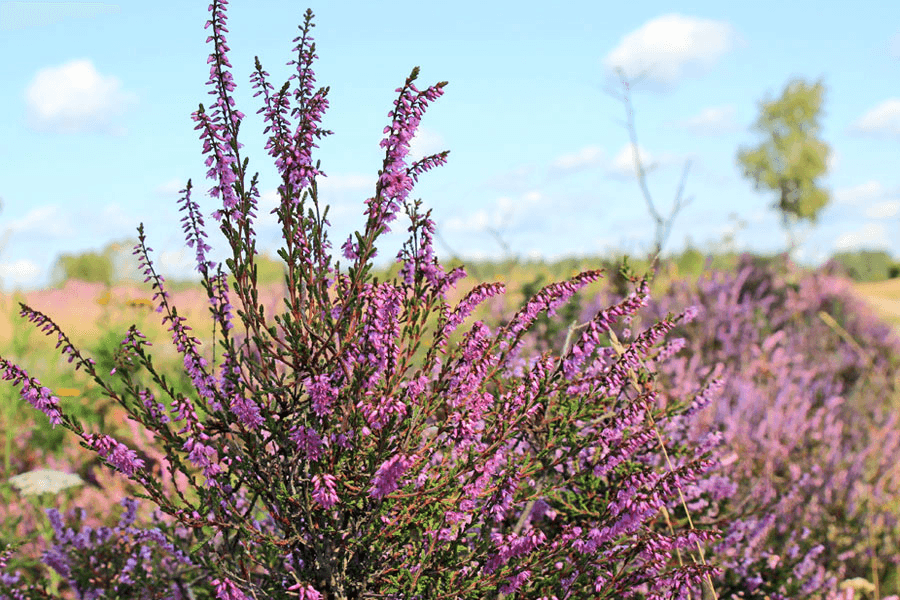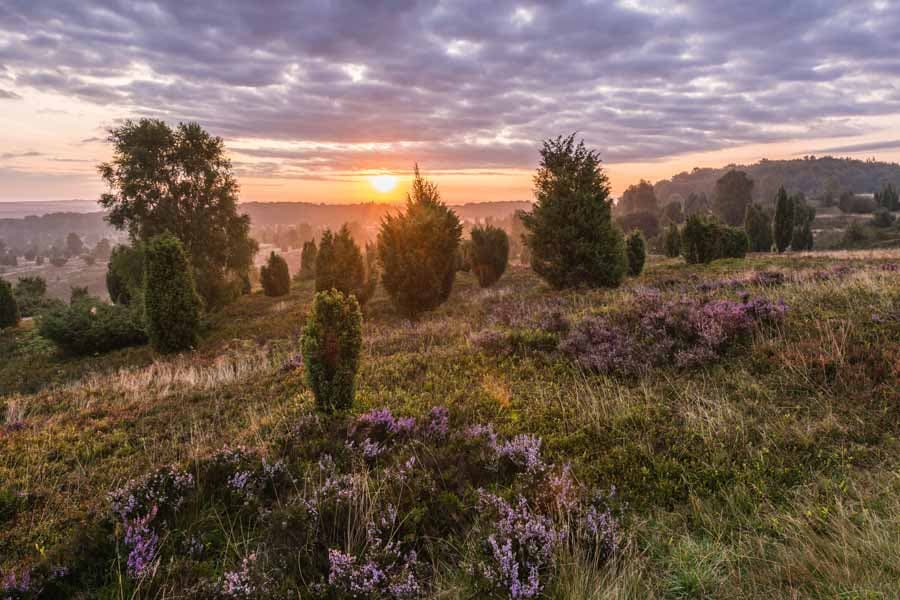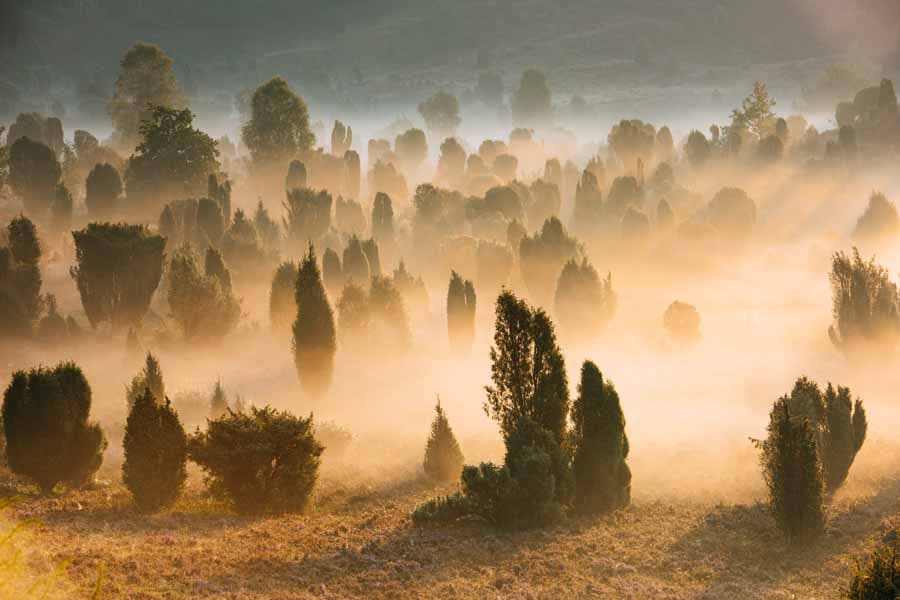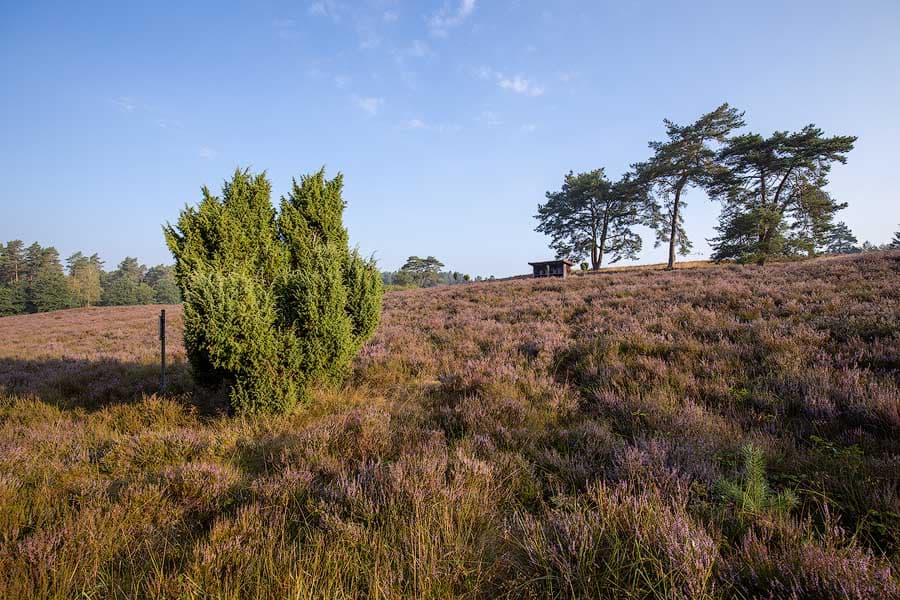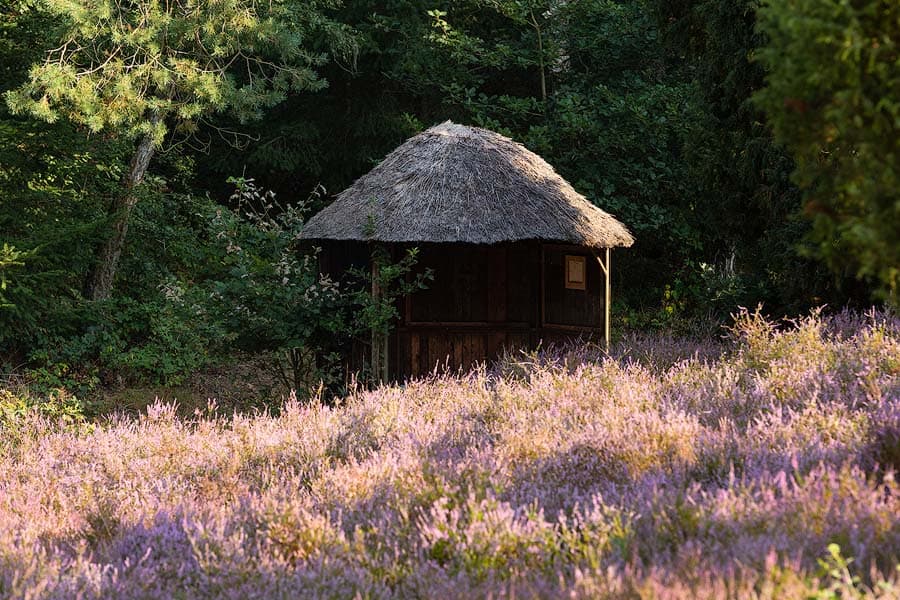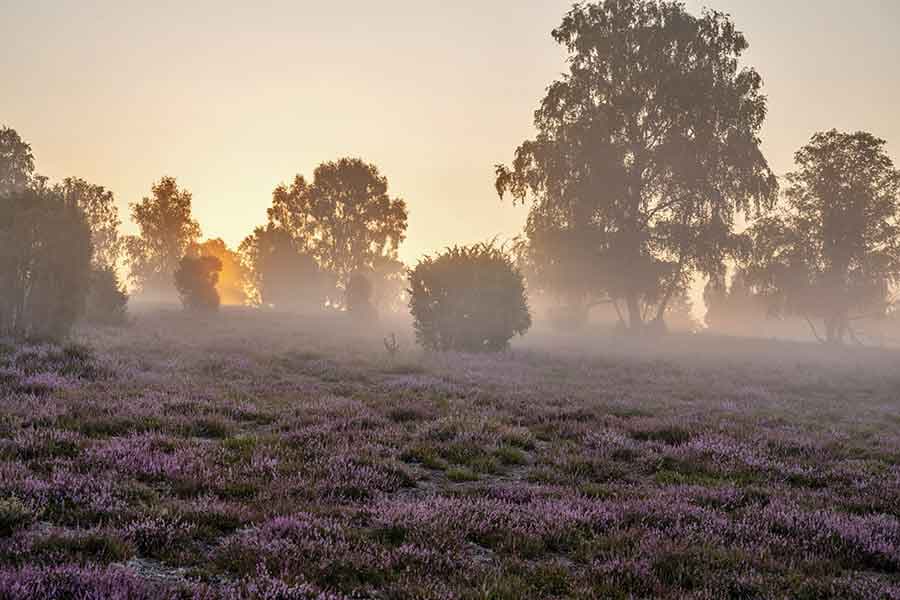
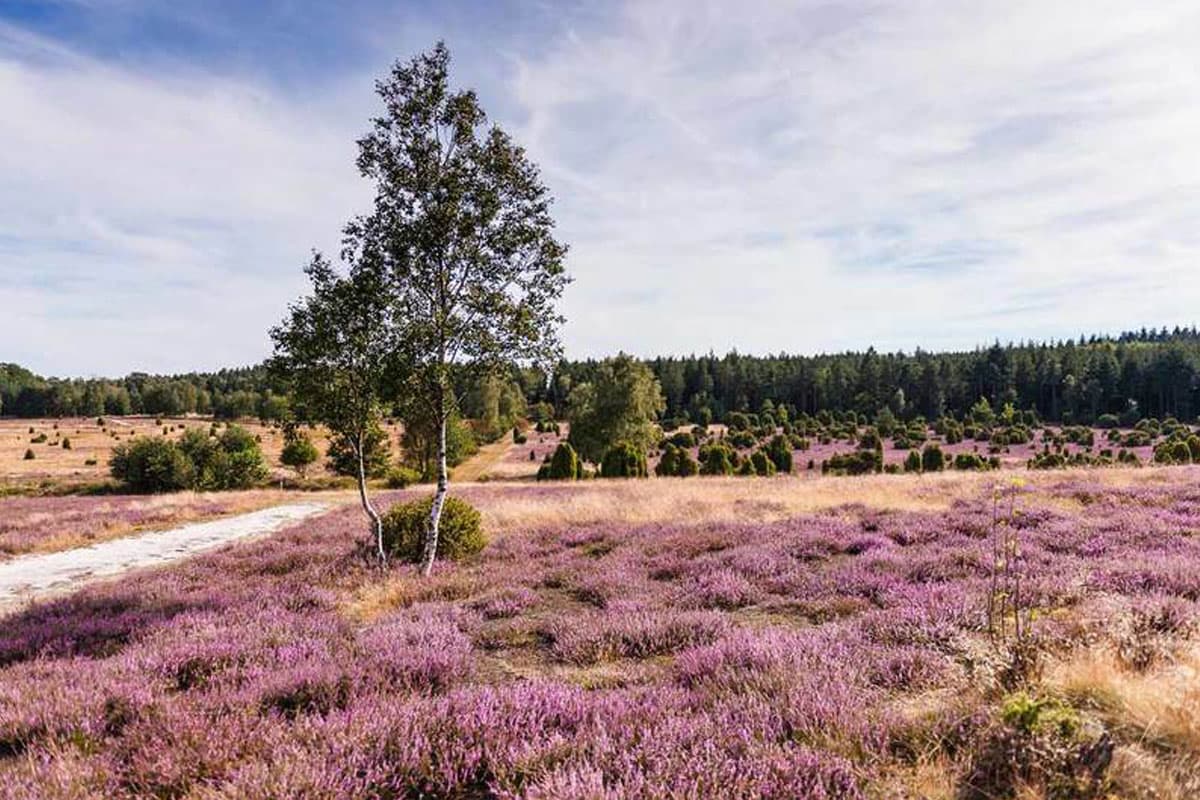
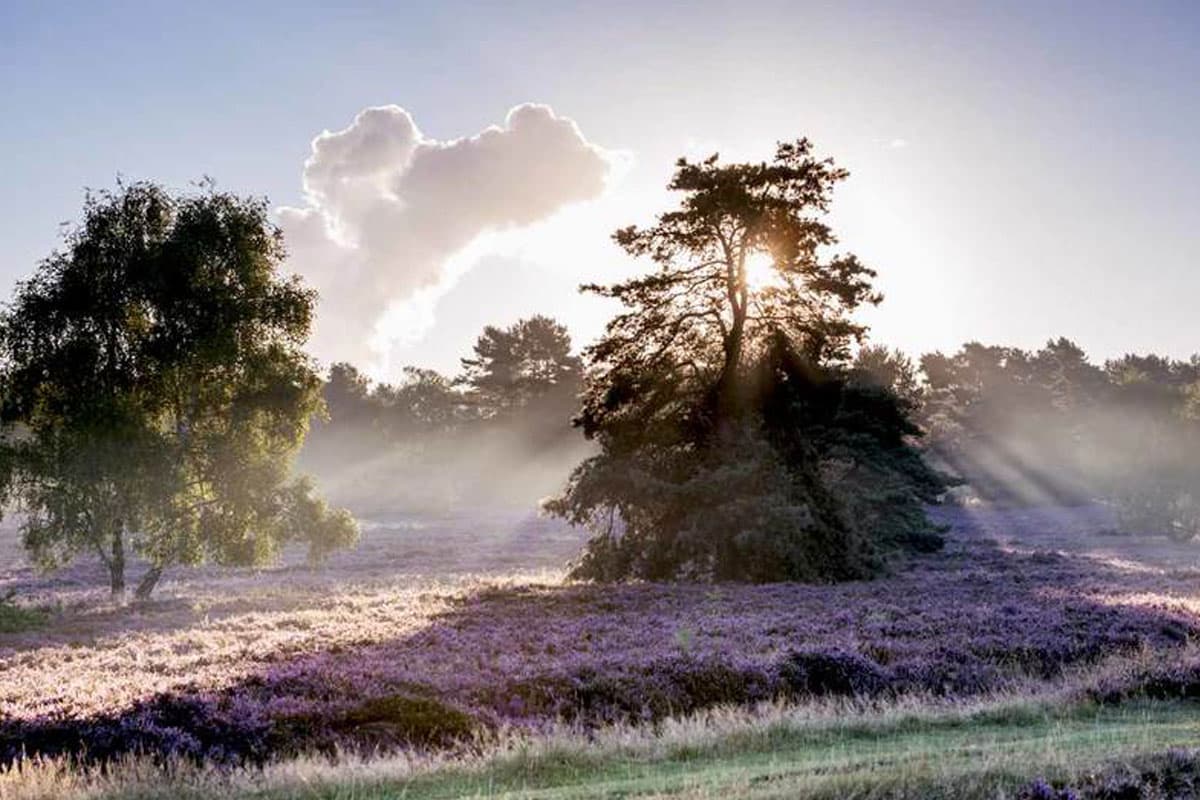
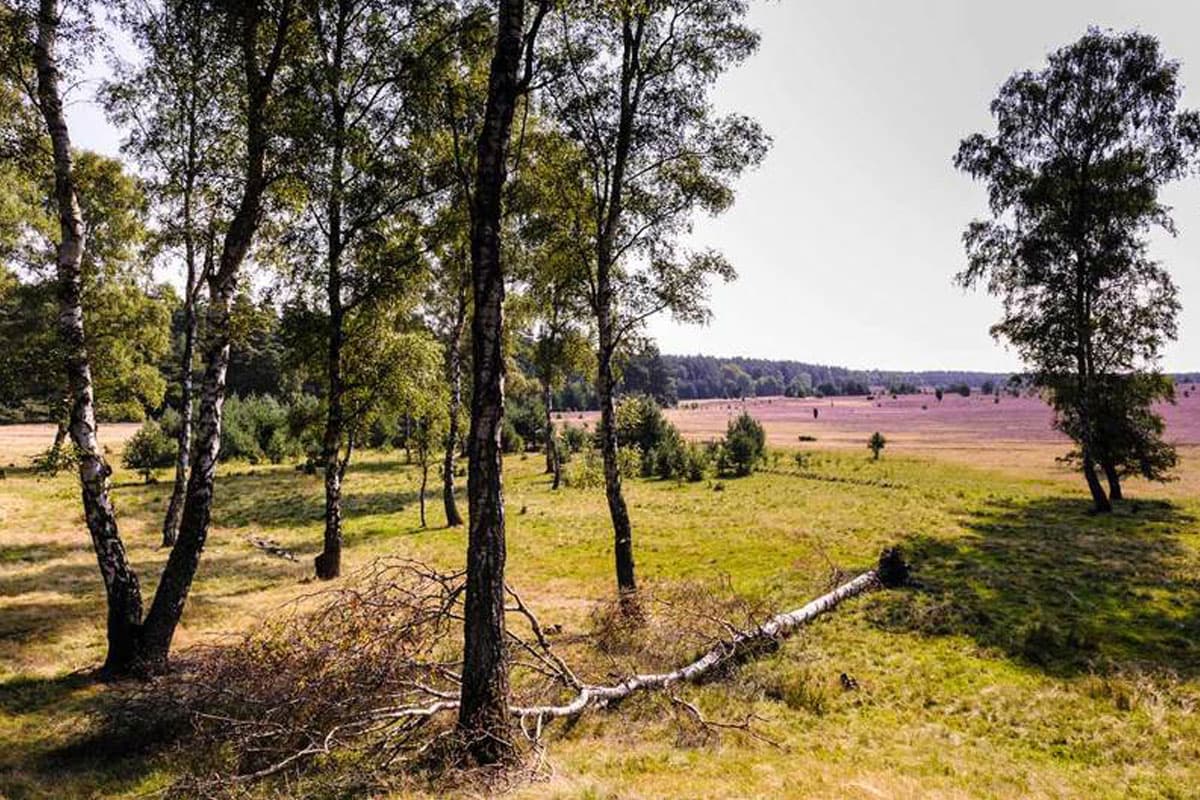
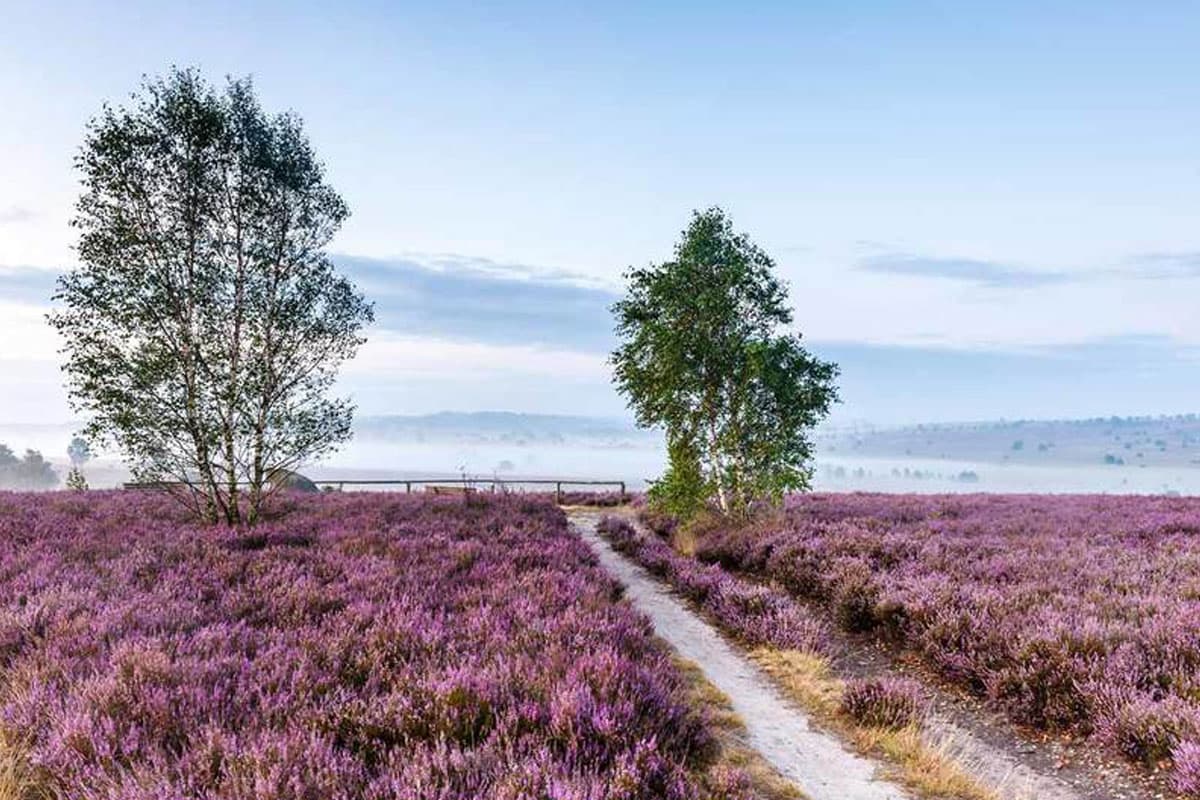
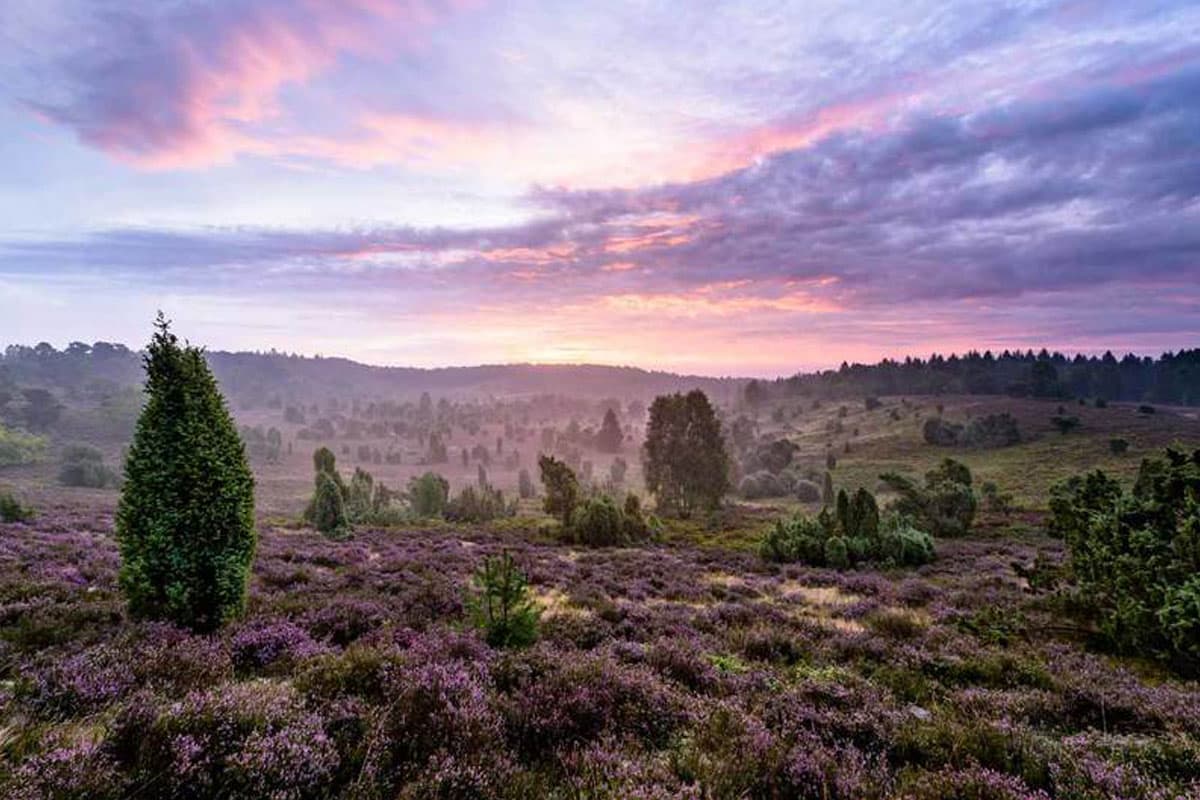
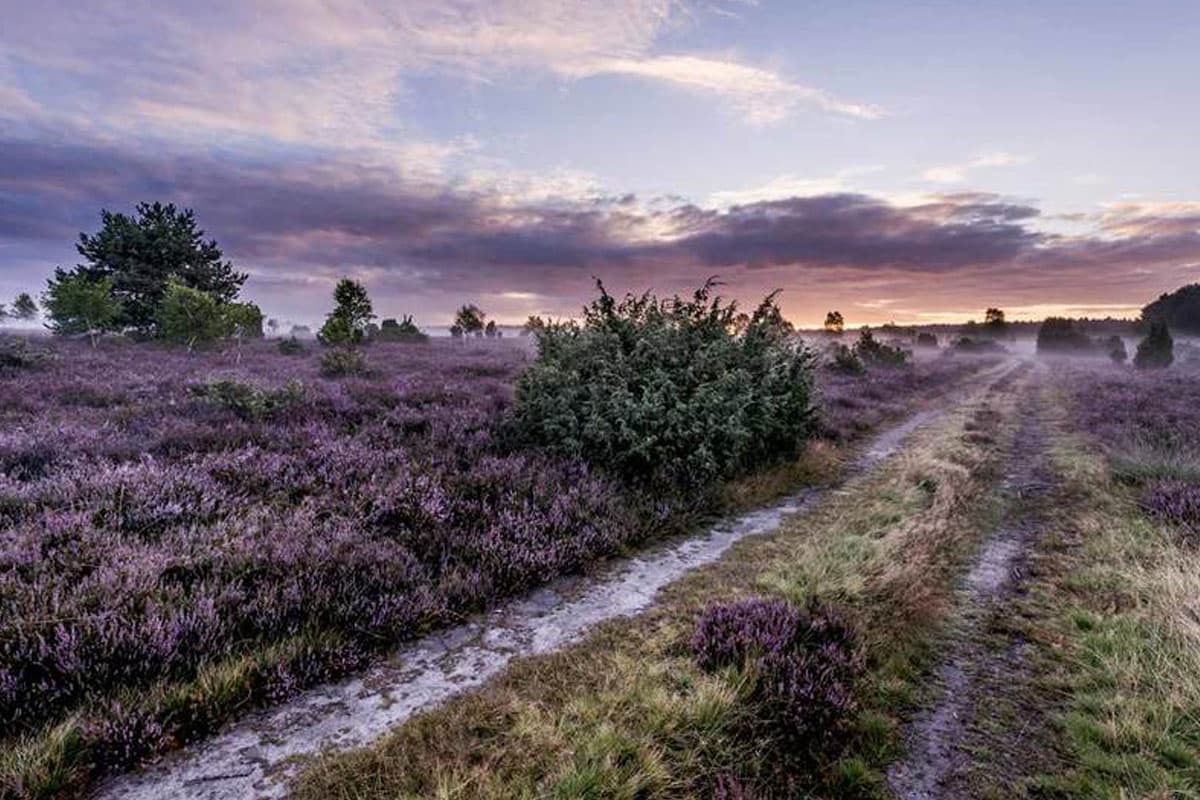
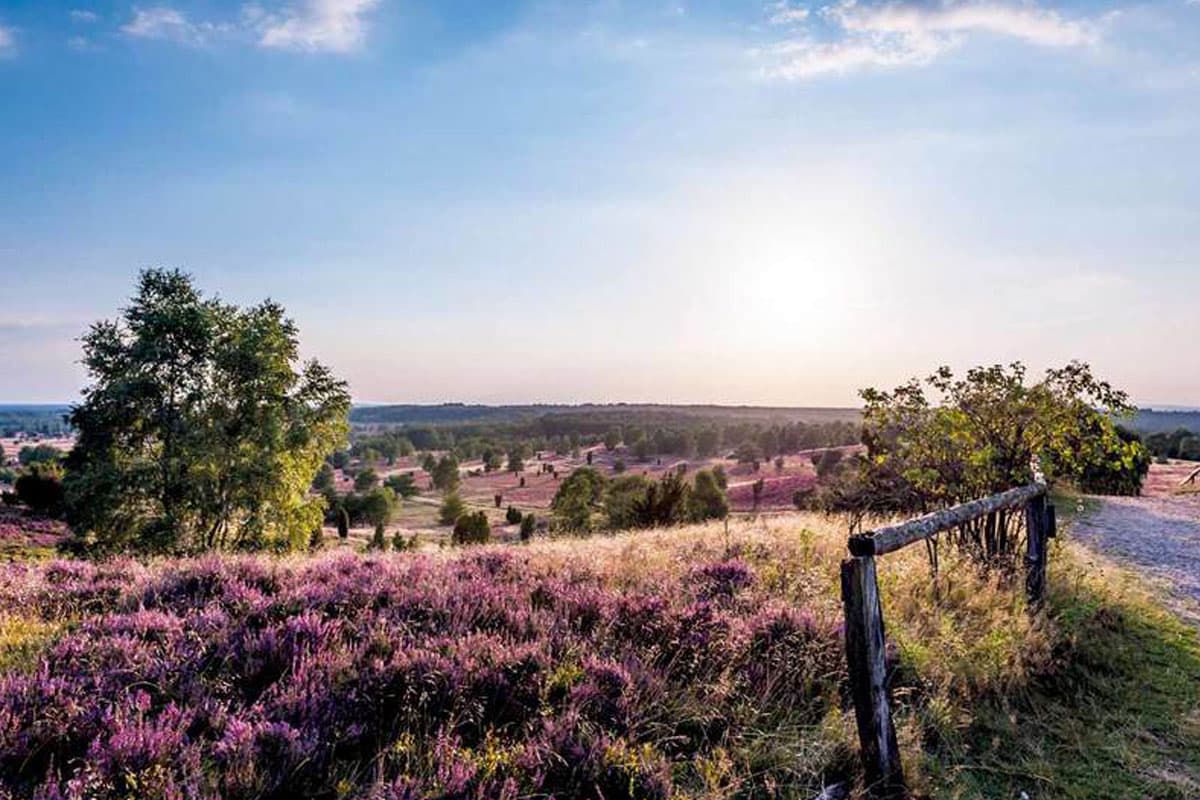
Millionen Besucher kommen in die Lüneburger Heide wegen der einzigartigen Heidelandschaften. Natürlich, denn die Lüneburger Heide verfügt über die größten zusammenhängenden Heideflächen Europas. Die Heideflächen sind die meistbesuchten Natur-Sehenswürdigkeiten der Heide.
Heideflächen der Lüneburger Heide
Entgegen weit verbreiteter Meinung besteht die Lüneburger Heide aber nicht aus einer einzigen Heidefläche, sondern es sind verschiedene Flächen unterschiedlicher Größe über die ganze Region verteilt. Die Schwerpunkte finden sich im Naturpark Lüneburger Heide im Norden und im Naturpark Südheide im Süden. Diese Heideflächen entwickeln sich auch in der Heideblüte zeitversetzt und unterschiedlich. Unser Heideblütenbarometer gibt Ihnen Auskunft, welchen Stand die Heideblüte in jeder Heidefläche hat.
Wo sind die schönsten Heideflächen in der Lüneburger Heide, wo kann man diese einzigartige Landschaft entdecken? Diese Frage stellt wohl jeder Urlauber. Wir haben daher alle wichtigen Heideflächen für Sie zusammengestellt. Sie finden dort Anreisebeschreibungen und Tipps. Die Liste aller Heideflächen finden Sie unten am Ende dieses Beitrags.
Am Ende dieses Beitrags können Sie sich unter "Anhänge" auch eine Karte aller Heideflächen der Lüneburger Heide herunterladen.
Wichtig: Vergessen Sie bei starkem Sonnenschein nicht, eine Kopfbedeckung und Wasser mitzunehmen. Die Heideflächen sind offene Landschaften und verfügen meistens über wenig Schatten.
Wo sind die schönsten Heideflächen?
Das ist nicht ganz einfach zu beantworten, jeder Geschmack ist anders. Sehr typische Heideflächen mit viel Wacholder findet man im Wacholderwald Schmarbeck, im Totengrund, im Steingrund und rund um den Wilseder Berg. Ein Schwerpunkt liegt sicher im autofreien Naturschutzgebiet. Diese Heideflächen mit den dunkelgrünen Wacholdern sind nicht nur zur Heideblüte im August und September schön, sondern vor allem auch im Herbst mit Nebel und im Winter mit Schnee.
Wer pflegt die Heideflächen?
Um die Heideflächen zu erhalten, ist eine aufwändige Pflege notwendig. Die Heide würde sonst ganz schnell zuwachsen, verkümmern und den vorhandenen Tieren keinen Lebensraum mehr bieten. Ein Großteil der Heideflächen ist in Privatbesitz des Vereins Naturschutzpark Lüneburger Heide (VNP). Diese Organisation pflegt auch die Heideflächen mit Millionensummen. Das geschieht durch die Heidschnuckenherden, oder auch maschinell. In der Südheide werden die Pflegemaßnahmen durch vom Naturpark beauftragte Firmen übernommen.
Die Heidepflanze: Calluna Vulgaris - Besenheide
Die Lüneburger Heide bietet mit ihren größten zusammenhängenden Heideflächen eine Naturlandschaft, die einmalig in Mitteleuropa ist. Die Heideflächen sind heutzutage aus der Region nicht mehr wegzudenken und geben ihr ihren typischen Charakter. Die Heidepflanze, die in der Lüneburger Heide vorrangig anzutreffen ist und ihre Landschaft prägt, ist die Besenheide – „Calluna vulgaris“. Sie wird häufig auch als Heidekraut bezeichnet. Die Besenheide ist die einzige Art der Pflanzengattung Calluna und gehört zur Familie der Heidekrautgewächse (Ericacecae) und zur Ordnung der Heidekrautartigen (Ericales). Auch die Glocken-Heide (Erica tetralix) ist ein Heidekrautgewächs und in der Lüneburger Heide zu finden. Sie blüht meist schon kurze Zeit vor der Besenheide.
Von Heidebauern, Heidschnucken und Heidebienen – Wie die Heidelandschaft entstanden ist
Wie wurden die Voraussetzungen für den Siegeszug dieses berühmten Krautes geschaffen? Ein Blick in die Jungsteinzeit: Erste Heidebauern siedeln sich an, roden Wald und betreiben Ackerbau. Doch mangels Dünger werden ausgelaugte Flächen der Natur überlassen. Die Zeit für das genügsame Heidekraut ist gekommen. Es erobert die ausgelaugten Ackerflächen. Im Mittelalter entdecken die Heidebauern dank der Schafzucht mit der Heidschnucke eine neue Wirtschaftsweise. Das anspruchslose Tier ist wichtiger Wolllieferant und Düngerproduzent für den Ackerbau. Die Streu für den Stall ringt der Bauer dem Erdboden ab. Mit sogenannten Plaggenhieben entreißt der Heidebauer dem Boden das Heidekraut samt Humusschicht. Diese schwere Tätigkeit, das Plaggen, hat schließlich das Wort „Plackerei“ hervorgebracht, das bis heute ein beliebtes Synonym für körperlich harte Arbeit ist. Neben der Heidschnucke macht sich auch die Biene unentbehrlich. Die weiten, baumlosen Heideflächen eignen sich hervorragend für die Imkerei. Honig, Bienenwachs und Heidschnuckenwolle sind nun wichtige Erzeugnisse der Heidebauern. Doch Anfang des 19. Jahrhunderts verdrängen Merinowolle, Petroleum und Rohrzucker die Heideprodukte. Aus der Not verkaufen Heidebauern ihr Land und die Flächen werden aufgeforstet.
An dieser Stelle hätte die Geschichte der historischen Heidelandschaft leicht ein Ende finden können. Denn die Einführung von Mineraldünger ermöglicht es den Bauern, Heidekartoffeln und Getreide auf unfruchtbarem Heideboden anzubauen. Die Folge: Immer mehr Heideflächen verschwinden in vielen Teilen Europas von der Landkarte. Aber nicht in der Lüneburger Heide. Denn hier sorgt der Verein Naturschutzpark e.V. (VNP) für ihren Erhalt.
Das Leben der Heidebauern früher - eine Zeitreise
Lassen Sie sich im Freilichtmuseum am Kiekeberg und im Museumsdorf Hösseringen in das Leben um 1800 entführen!
Wie lebten die Menschen vor über 200 Jahren in den Heidedörfern der Lüneburger Heide? Ein Rundgang durch die historischen Häuser der beiden Freilichtmuseen hinterlässt Eindrücke über das Arbeiten und Leben der Menschen.
Landschaft, die viel Pflege braucht
Die Heide ist ein Kraut, das viel, Pflege braucht. Ohne Pflegemaßnahmen vergrasen und verbuschen die Heideflächen und neu entstehende Wälder verdrängen die Heide.
Das Heidekraut kann vor allem auf nährstoffarmem Boden wunderbar gedeihen. Durch Nährstoffzufuhr aus der Luft werden bestimmte Süßgräser wie die Drahtschmiele und das Pfeifengras gefördert, welche die Besen- und Glockenheide auf Zeit verdrängen.
Dank der Pflege durch die Naturparke Lüneburger Heide und Südheide sowie den Verein Naturschutzpark e.V. (VNP) bleiben die Heideflächen erhalten. Hierfür werden unterschiedliche Methoden angewendet, von denen wir Ihnen drei vorstellen möchten:
Beweidung - Heidschnucken sind fleißige Landschaftspfleger
Was wäre die Lüneburger Heide ohne Schnuckenherden? Die Beweidung mit Heidschnucken ist wohl die bekannteste Methode, die Heide zu pflegen. Die Schnucken verbeißen junge Bäume und verhindern so, dass sich Birken- und Kiefernwälder auf den Heideflächen ausdehnen können. Gleichzeitig pflegen sie auch die Heide. Die Heidepflanzen sollten auf einer Länge von 15 cm gehalten werden, um jung und dicht zu bleiben und um ihre Blütenpracht entwickeln zu können.
Wird die Heide länger und älter, dann verholzt sie. Die Heidschnucken sorgen durch ihren Verbiss für einen jungen Austrieb. Und noch etwas bewirken die Schnucken: Sie zerstören die kleinen Spinnweben zwischen den Heidepflanzen und ermöglichen somit den Bienen einen freien Flug.
In jeder Heidschnuckenherde sind auch Ziegen zu sehen. Sie unterstützen die Schnucken, da sie noch stärker die Pioniergehölze wie Birken und Kiefern verbeißen können.
Über 9.000 Heidschnucken in 13 Herden ziehen an 365 Tagen im Jahr durch die Heideflächen der Lüneburger Heide.
Entkusseln - Der Mensch unterstützt die Schnucken
Beim Entkusseln werden mit Spaten, Sägen und Astscheren aufkommende Pionierbaumarten entfernt. Jedes Jahr finden in den Naturparken Lüneburger Heide und Südheide Entkusselaktionen statt, an denen sich zahlreiche freiwillige Helfer beteiligen.
Feuer und Flamme für die Heide.
Das gezielte und kontrollierte Abbrennen der Besenheide ist eine altbewährte Pflegemethode zu ihrer Erhaltung. Überalternde Bestände werden auf diese Weise verjüngt und revitalisiert. Die Besenheide ist ein typischer Brandkeimer.
Die unterirdischen Teile der Besenheide ertragen Hitze sehr gut, besonders dann, wenn der Boden genug Feuchtigkeit gespeichert hat, um die unterirdischen Pflanzenteile und die im Boden lagernden Samen zu schützen. Manchmal wachsen bereits im Folgejahr die ersten Heidepflanzen aus dem verbrannten Oberboden wieder hervor.
5 Tipps für den Besuch der Heideflächen
- Vergessen Sie bei starkem Sonnenschein nicht, eine Kopfbedeckung und Wasser mitzunehmen. Die Heideflächen sind offene Landschaften und verfügen meistens über wenig Schatten.
- Das Betreten der Heide ist verboten. Wenn Sie gerne Fotos von sich in der Heide machen möchten, nutzen Sie bitte die schmalen, ausgeschilderten Sandwege. Die sind auf dem Foto nachher nicht zu sehen. Auch Hunde müssen angeleint bleiben und dürfen, wie Menschen, die Wege nicht verlassen
- Die meisten Heideflächen sind Naturschutzgebiete, es gibt nicht an jeder Ecke einen Kiosk. Bitte planen Sie ihr Lunchpaket schon vorher mit ein.
- Lassen Sie sich im Freilichtmuseum am Kiekeberg und im Museumsdorf Hösseringen in das Leben um 1800 entführen! Wie lebten die Menschen vor über 200 Jahren in den Heidedörfern der Lüneburger Heide? Ein Rundgang durch die historischen Häuser der beiden Freilichtmuseen hinterlässt Eindrücke über das Arbeiten und Leben der Menschen.
- Fast alle Heideflächen sind Naturschutzgebiete. Es gibt keine Toiletten und Mülleimer. Bitte nehmen Sie daher Ihren Müll wieder mit, bevor ihn die Tiere fressen. .

